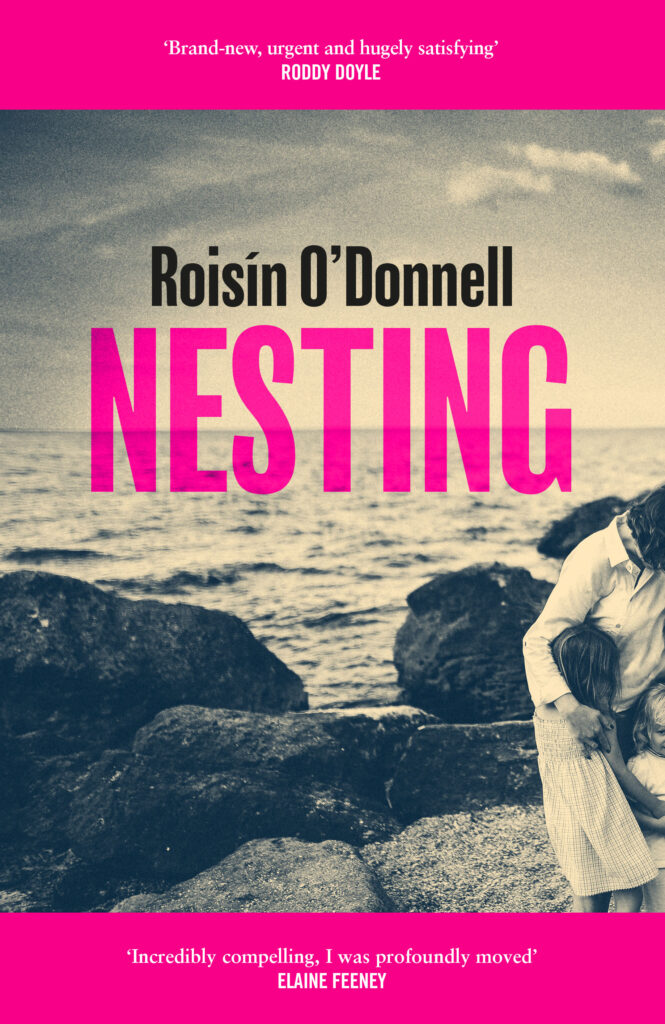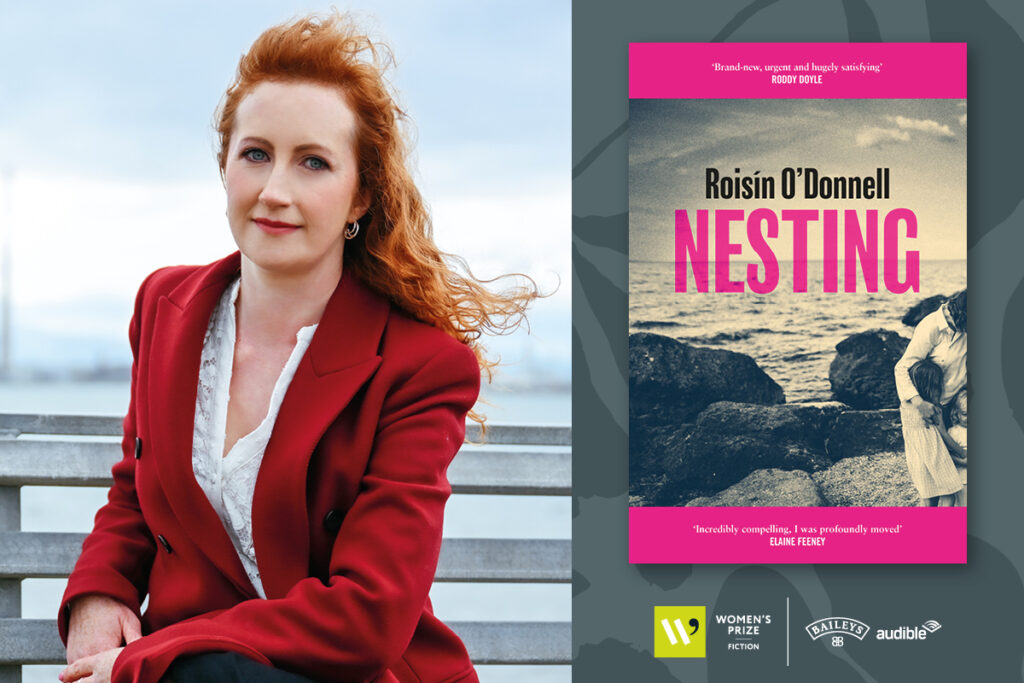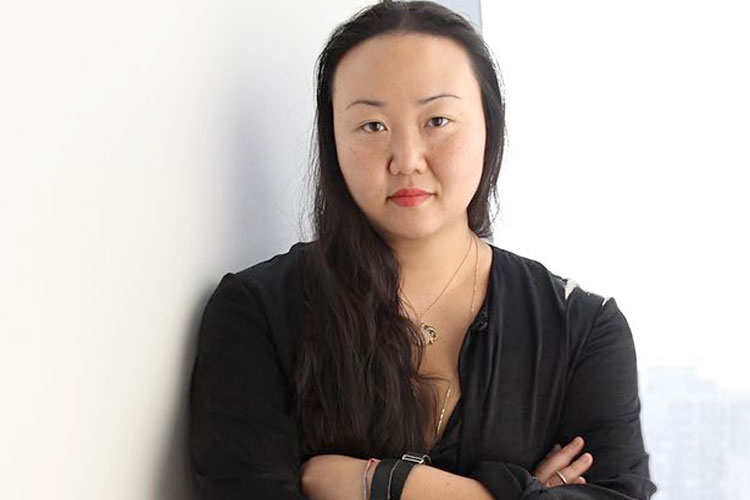Roisín O’Donnell’s Nesting follows a woman who flees with her children from domestic abuse only to face the uncertainty of a housing system about to collapse.
Longlisted for the 2025 Women’s Prize for Ficton, Chair of judges Kit de Waal says the book is a ‘moving story, well told about what it’s like to try and leave an abusive relationship, the hurdles, the stigma, the doubt, the ease and temptation of return. Not maudlin or depressing, there’s lots of light here but ultimately this is about a system ripe for change where getting help is nearly as hard as escape itself.’
To find out more about the book we spoke to Roisín about her inspirations, writing process and favourite books.
How would you describe your book to a new reader?
Nesting is the story of one woman’s bid to escape a controlling relationship and reclaim her life. From the outside, it seems that Ciara Fay has it all. A comfortable home in the Dublin suburbs, two children and a husband who seems attentive and reliable. But behind closed doors, Ciara has become isolated, a shadow of her former self. Her husband Ryan monitors her every move and has cut her off from her friends, her work and her beloved family. On discovering she is pregnant again, Ciara reaches breaking point. Seizing this moment of clarity, she takes her two children, bundles the clothes from the washing line and drives away, determined that this time she is not coming back. But leaving is one thing, staying away is another. With nowhere to go, Ciara finds herself living in emergency accommodation in a dingy hotel, faced with Ryan’s relentless campaign to get her to come back, and the voice of her own demons. Nesting is about Ciara’s quest to regain autonomy in the face of all the challenges she faces, and to rebuild a life for herself and her children.
What was the idea that sparked your novel?
Nesting was sparked by a single word. In 2020, I was commissioned to write a story for radio on the theme of ‘independence’. This was at the height of lockdown, when we were all being told to ‘stay home, stay safe’. But what if home was the least safe space you could be? What if you didn’t have a home? In the news, I had been hearing stories about the rise in the number of calls to Women’s Aid, and the escalating numbers of people living in emergency accommodation. I wrote a story for radio called Present Perfect, about a woman called Ciara Fay who is living in a hotel with her two children, having left an abusive relationship. The story charted a day in Ciara’s life, filled with struggles and small triumphs. It was read brilliantly by Siobhán McSweeney, but even as I sat in my kitchen with a cup of tea, listening to my story being broadcast on national radio, I felt a niggling sense of dissatisfaction. I wanted to know what would happen next. Would Ciara manage to completely break free from her toxic ex-partner? Would she find a home for herself and her children? The story wouldn’t let me go. There was only one way to find out the answers I was craving; I would have to keep writing. The result is Nesting.
Which part of the book did you write first? Was there a moment that clicked a lot of things in place or where you felt the strands of the book started to come together?
The scene where Ciara takes the clothes from the washing line, gets the children into the car and leaves was the first scene I wrote, and it is the only scene from Nesting which features in the original short story Present Perfect. At that point, I didn’t even know who this woman was, let alone where she was going! But I remember seeing the whole scene in my mind’s eye so clearly. I didn’t know exactly what Ciara had been through, but I could sense her desperation and determination in that moment. It’s a spring day, the clothes are drying on the line, bubbles are spinning in slow motion, and she has a moment of absolute clarity where she thinks ‘this is it’.
At that point, I really didn’t know what would happen next. Before this, I had been writing short stories mostly, and I’d often have the whole story mapped out in my mind before I began writing it down. With a novel, I quickly realised that would not be possible. I would have to embrace the vulnerability of not knowing what would happen next, and allow my characters to guide the story. I had to place myself entirely in Ciara’s shoes.
When Ciara stepped back into the classroom again and started teaching, it felt like a real moment of change in the story. Up until that point, much of my writing had been concerned with her leaving the relationship, and the struggles she faces in finding accommodation, the stress and pressure she is under from Ryan. Then when her cousin suggests she could start teaching again, and she stands in front of a class for the first time in years, I could feel her sense of self reawakening. I realised then that Nesting wasn’t going to be just about the nightmare of escaping an abusive relationship. It was also going to be about female strength, found family, resilience and discovering hope in the most impossible of circumstances.
Which part of the book was the most fun to write? Which was the most challenging?
I was instantly drawn to Ciara as a character: to her vulnerability, her reckless hopefulness and her determination to reclaim the life that has been taken from her. I particularly enjoyed writing about the friendships she forges over the course of the novel, and the ways in which she begins to recover her sense of self. From the straight-talking Cathy, to her tentative love-interest Diego, and the students she teaches at the English language school; it was a joy to experience Ciara reconnecting with other people again. It felt like letting the light back into her life.
Scenes when Ryan is at his most threatening and manipulative were challenging from an emotional point of view. The climactic scene near the end when baby Noah is missing was challenging to the extent that, in earlier drafts, this part of the book was sketched in almost like a blue print. I hardly dared allow myself to go there. In later drafts, I had to force myself to fully inhabit the scene, and to take the reader beat-by-beat through Ciara’s emotions. Some of this involved writing on location, going to the various settings and imagining myself in Ciara’s shoes; from this I was able to get a sense of her fear, but also her rising strength.
Throughout the writing of Nesting, the challenge was always to make sure that the story felt authentic and engaging. I tried to let the character of Ciara lead the way, so the tension and pacing are all generated from the situation she is in. In novels and in films, there are so many harmful stereotypes of women in Ciara’s position, and I wanted to break through these and tell a story that felt validating and real.
What is the best piece of writing advice you have ever received?
‘Embrace what is new in your work. The only thing to fear is stasis!’
A friend said this to me when I was in the early stages of writing Nesting. At that point, in 2021, I had not written anything for a long time, apart from Present Perfect, the short story for radio. I had published a short story collection in 2016, but since then circumstances had changed. The hunger to write was still there, but my dreams of writing a novel just felt impossible. Between work and parenting, I had so little writing time, and my confidence was very low. But Ciara Fay came along, and this story began to carry me along with its own energy. Nesting felt so different from anything I had ever written before, and I was almost a bit afraid of that. This seemed like a complete departure from my earlier stories. But then, as my friend pointed out, my life had changed beyond recognition, so of course my writing had evolved too. With this valuable advice, she gave me permission to embrace Nesting as something entirely new, and not be afraid of breaking the mould.
Which female author would you say has impacted your work the most?
I first discovered the work of Edna O’Brien as an undergraduate, and The Country Girls trilogy had a real impact on me. The voices of her characters were still so vivid, and she was challenging perceived notions about Irish womanhood in a way that was extremely radical for her time. I think that all Irish women writers are in her debt in a way, because she broke through so many taboos and paved the way for other stories to be told. Even in her later work, she was so fearless. I admire the momentum of her stories and her bravery.
What is your favourite book from the Women’s Prize library and why?
Demon Copperhead by Barbara Kingsolver is a book I deeply admire. I love Demon’s voice. This novel is so character driven; from that very opening line, ‘first I got myself born’, we are entirely in his world. I admire how Kingsolver created a compelling story with the opioid crisis at its heart, without ever seeming cold or didactic. This is Demon’s story, and readers are rooting for him the whole way. Kingsolver also manages to stir such a sense of outrage about the big pharma companies who are preying on this vulnerable rural community. It made me feel so angry, because I knew it was so real. I think Kingsolver is a wonderful role model; she recently announced that she is using the royalties from Demon Copperhead to build a new rehab centre in her area. I was so moved by that.
Could you reveal a secret about your creative process?
As a single parent, working full-time as a teacher, writing time is often in short supply, so I have to come up with creative solutions. One method is getting up early in the morning to write, before my children wake up. I find there is something valuable about starting the day with writing, before my critical faculties have fully kicked in, and while I am not yet in demand. While writing Nesting, I got into a habit of writing on my phone. Many sections of the book were typed into my phone, early in the morning, in the wee small hours; on my lunch break; cooking dinner, or during some stolen moment from the day. At the time, this was done out of necessity but I think there was a certain value to it from a craft point of view. E.L Doctorow said writing is ‘like driving a car in the fog at night. You are only able to see as far as the headlights, but you can make the whole trip that way’. Writing on the small screen of the phone, I could only see a couple of sentences at a time, so it forced me to focus on the immediacy of Ciara’s story beat by beat.









